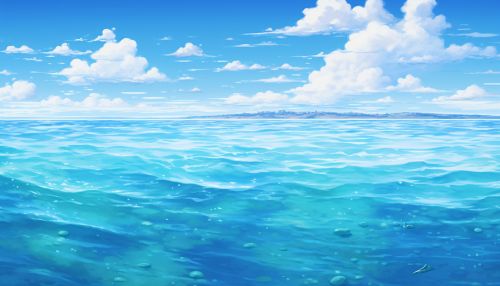Oceanic carbon cycle
Introduction
The oceanic carbon cycle is a complex system of processes that exchange carbon – in the form of CO2 and carbonate ions – between the ocean, the atmosphere, and the seafloor. This cycle plays a critical role in regulating Earth's climate by absorbing and storing a large portion of the carbon dioxide emitted by human activities.


The Role of the Ocean in the Carbon Cycle
The ocean is a major reservoir of carbon, containing approximately 50 times more carbon than the atmosphere. It absorbs about a quarter of human-generated CO2 emissions, reducing the impact of greenhouse gases on climate change. This absorption occurs primarily at the ocean's surface, where CO2 from the atmosphere dissolves into the water. Once in the ocean, carbon dioxide can remain for hundreds to thousands of years, a process known as oceanic carbon storage.
Physical Processes
Gas Exchange
The exchange of CO2 between the atmosphere and the ocean is a physical process driven by the difference in CO2 concentration between the air and the water. This process, known as gas exchange, is influenced by several factors, including wind speed, sea surface temperature, and salinity.
Ocean Circulation
Ocean circulation also plays a crucial role in the oceanic carbon cycle. Surface waters absorb CO2 and transport it into the deep ocean through the process of thermohaline circulation, also known as the ocean conveyor belt. This process is driven by differences in water density, which is affected by temperature and salinity.
Biological Processes
Photosynthesis
Marine plants and algae, known as phytoplankton, absorb CO2 from seawater through photosynthesis. This process converts CO2 into organic carbon, which is then used to build plant tissues.
Carbon Export and Sequestration
When phytoplankton die or are consumed by other organisms, the carbon they contain can be transported to the deep ocean, a process known as the biological pump. Over time, this organic material can become buried in the seafloor, sequestering the carbon for millions of years.
Human Impact and Climate Change
Human activities, particularly the burning of fossil fuels and deforestation, have significantly increased the amount of CO2 in the atmosphere. This has led to an increase in the amount of CO2 absorbed by the ocean, causing a phenomenon known as ocean acidification. This increased acidity can have harmful effects on marine life, particularly organisms with calcium carbonate shells or skeletons.
Conclusion
The oceanic carbon cycle is a complex and vital process that regulates Earth's climate. Understanding this cycle is crucial for predicting future climate change and developing strategies to mitigate its effects. However, human activities are altering this cycle, with potentially serious consequences for the ocean and its ecosystems.
